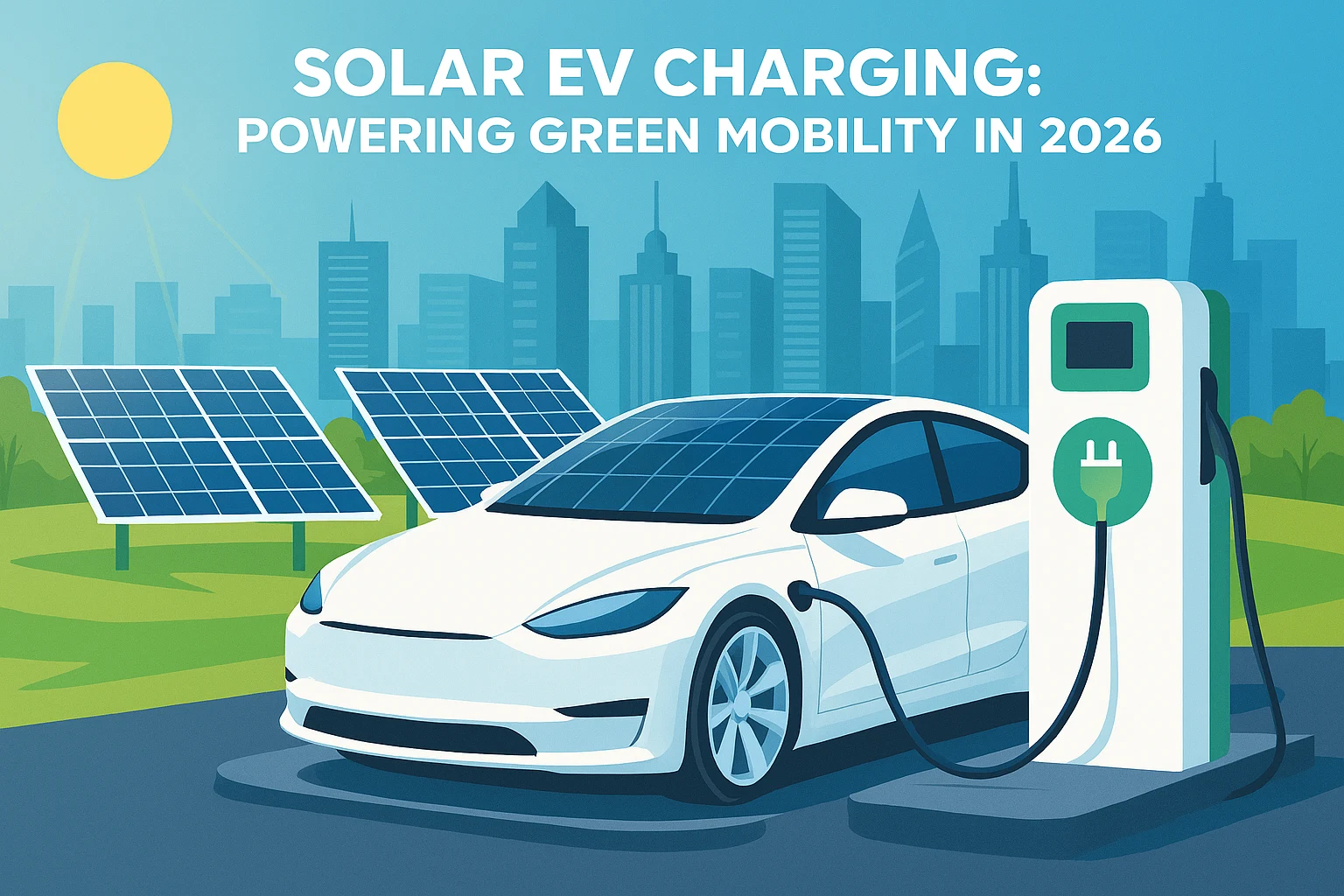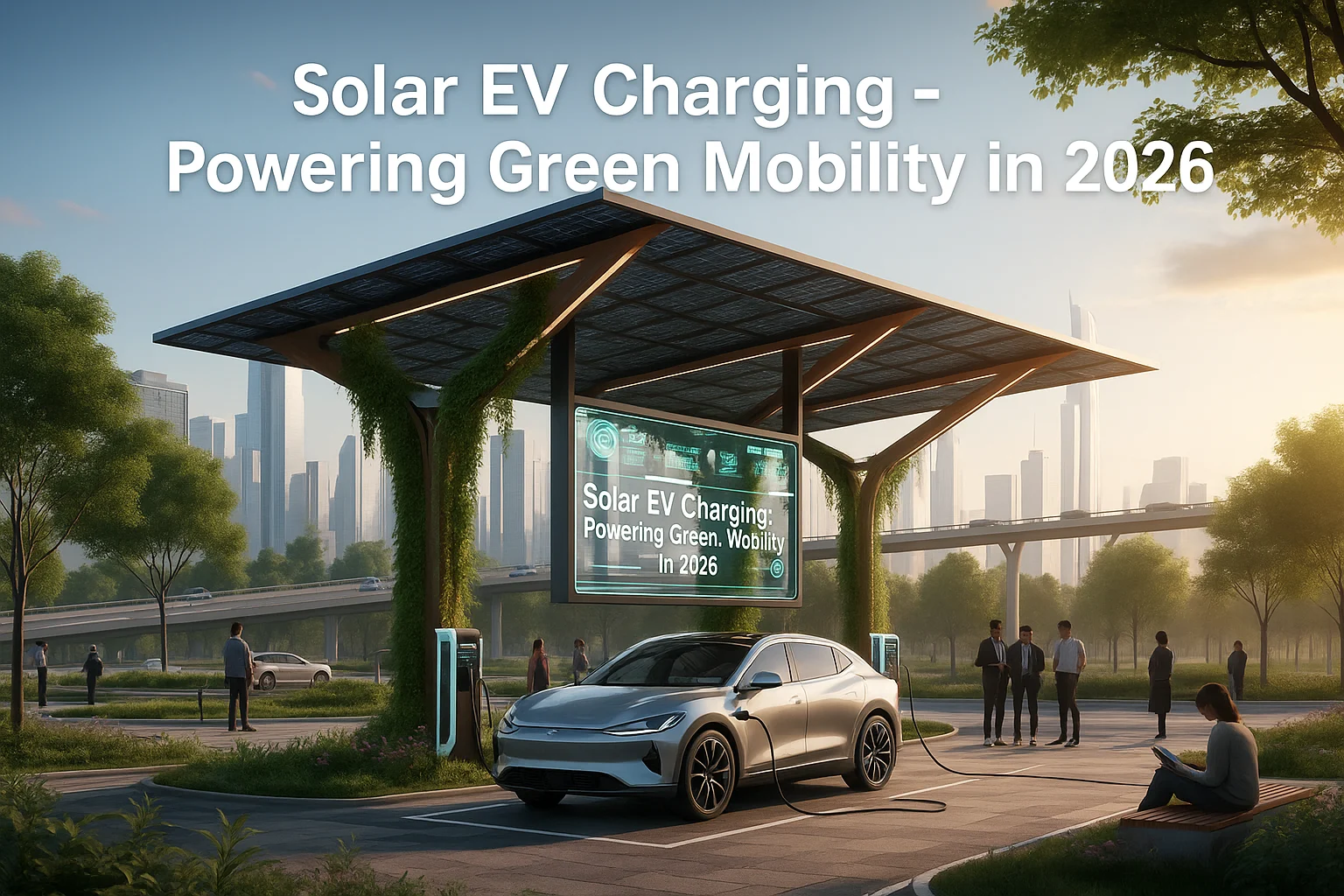Solar EV Charging
As the world accelerates toward a sustainable future, solar-powered electric vehicle (EV) charging stations are emerging as a cornerstone of green mobility in 2026. With global EV adoption projected to surpass 30% of new vehicle sales, the demand for clean, renewable charging solutions is soaring. Moreover, solar energy, with its plummeting costs and technological advancements, offers an ideal synergy with EVs to reduce carbon footprints. However, challenges like infrastructure gaps and grid dependency persist. Consequently, solar EV charging stations are not just a trend but a necessity, blending renewable energy with transportation. This article explores the top innovations, benefits, and challenges of solar-powered EV charging in 2026, highlighting how it drives decarbonization. By integrating AI, advanced solar panels, and smart grids, these stations promise to redefine mobility. Therefore, stakeholders must embrace this revolution to power a greener tomorrow.

Solar EV Charging
The Rise of Solar-Powered EV Charging
Global Adoption Trends
Solar EV Charging
The global shift toward electric vehicles is reshaping transportation, with solar-powered charging stations gaining momentum in 2026. For instance, EV sales are expected to reach 18 million units annually, driven by policies like the EU’s zero-emission mandates. Moreover, solar installations are projected to add 500 GW globally, with 20% dedicated to EV charging infrastructure. In addition, countries like China and India are deploying solar stations at scale, supported by government subsidies. However, urban areas face space constraints, pushing innovations like solar canopies. Consequently, the International Energy Agency (IEA) predicts solar EV charging will power 10% of EVs by 2026, reducing reliance on fossil-fuel grids. Furthermore, consumer demand for sustainable solutions fuels adoption, with 70% of EV buyers prioritizing green charging options. Therefore, solar EV charging is a key driver of the mobility revolution, aligning with global decarbonization goals.
Why Solar and EVs Are a Perfect Match
Solar energy and EVs form a symbiotic relationship, amplifying sustainability. Primarily, solar power offers a renewable, low-cost energy source, with panel prices dropping 80% since 2010. In contrast, traditional grid charging often relies on coal or gas, undermining EV benefits. Moreover, solar stations reduce grid strain during peak hours, enhancing stability. For example, vehicle-to-grid (V2G) technology allows EVs to return stored solar energy to homes or grids. However, scalability requires addressing land use and installation costs. Consequently, innovations like rooftop solar chargers are gaining traction in urban settings. Furthermore, pairing solar with EVs cuts lifetime emissions by 50% compared to gas-powered vehicles. As a result, this synergy positions solar EV charging as a cornerstone of green mobility in 2026, offering a blueprint for net-zero transportation systems worldwide.

Technological Innovations in 2026
Advanced Solar Panels for Charging
By 2026, solar panel advancements are revolutionizing EV charging. Specifically, perovskite solar cells achieve efficiencies of 30%, surpassing traditional silicon’s 22%. For instance, bifacial panels, capturing light from both sides, boost output by 15-25% in charging stations. Moreover, their lightweight, flexible designs enable integration into carports and canopies. However, durability concerns are being addressed through advanced encapsulation, extending lifespans to 25 years. Consequently, these panels reduce charging costs by 20%, making solar stations economically viable. In addition, transparent solar panels on EV windows generate supplementary power, enhancing range. Therefore, these innovations make solar EV charging more efficient and accessible, supporting widespread adoption across urban and rural landscapes.
Battery Storage Integration
Battery energy storage systems (BESS) are critical for solar EV charging in 2026. Primarily, lithium-ion and emerging solid-state batteries store excess solar energy, ensuring 24/7 availability. For example, a single station with BESS can charge 50 EVs daily without grid reliance. Moreover, costs have fallen 89% since 2010, enabling affordability. However, long-duration storage, like iron-air batteries, extends discharge to days, addressing solar intermittency. Consequently, stations with V2G capabilities allow EVs to act as mobile storage units, stabilizing grids. Furthermore, AI optimizes charge-discharge cycles, cutting energy waste by 30%. As a result, BESS integration transforms solar EV charging into a reliable, scalable solution, driving green mobility forward.
AI and Smart Grid Optimization
Artificial intelligence is a game-changer for solar EV charging in 2026. Specifically, AI predicts EV charging demand with 95% accuracy, optimizing solar energy allocation. For instance, smart grids balance loads, reducing peak-time strain by 20%. Moreover, AI-driven drones adjust panel angles in real-time, boosting efficiency by 25%. However, data privacy concerns require robust cybersecurity frameworks. Consequently, edge computing enables local processing, enhancing speed and security. In addition, AI integrates with V2G systems, allowing EVs to feed surplus energy back to grids. Therefore, AI and smart grids make solar charging stations intelligent hubs, ensuring seamless, sustainable energy delivery for EVs.
Benefits
Environmental Impact
Solar-powered EV charging significantly reduces greenhouse gas emissions. For example, a solar-charged EV emits 50% less CO2 over its lifetime compared to grid-charged counterparts. Moreover, by replacing fossil-fuel-based charging, these stations cut global emissions by an estimated 1 Gt annually by 2030. In addition, solar stations reduce air pollution, improving urban health outcomes. However, manufacturing impacts require sustainable practices, like panel recycling. Consequently, Solar Car Charging aligns with global climate goals, supporting the Paris Agreement’s 1.5°C target. Furthermore, it preserves ecosystems by minimizing mining for fossil fuels. As a result, this technology is a vital tool for combating climate change in 2026.
Economic Advantages
Economically, solar EV charging offers substantial savings. Primarily, solar energy’s low operational costs reduce charging expenses by 30% compared to grid power. For instance, businesses deploying solar stations report 15% higher ROI due to energy independence. Moreover, government incentives, like India’s PM Surya Ghar subsidies, offset installation costs. However, upfront investments remain a hurdle for small operators. Consequently, financing models like leasing make adoption accessible. In addition, job creation in solar and EV sectors is projected to reach 5 million globally by 2026. Therefore, solar charging stations drive economic growth while fostering sustainable transportation solutions.
Energy Independence
EV charging from solar enhances energy independence for individuals and communities. Specifically, off-grid stations powered by solar and BESS free users from unreliable grids. For example, rural areas in Africa benefit from standalone chargers, serving 10 million EVs by 2026. Moreover, V2G technology allows homeowners to power residences with EV-stored solar energy. However, infrastructure scaling requires investment in microgrids. Consequently, decentralized systems reduce reliance on centralized utilities. Furthermore, this independence bolsters resilience against outages, especially in disaster-prone regions. As a result, solar charging fosters self-sufficiency, redefining mobility in 2026.
Challenges and Solutions
Infrastructure and Cost Barriers
Deploying Solar Car Charging stations faces infrastructure and cost challenges. Primarily, high initial costs for panels and BESS deter small-scale adoption. For instance, a single station costs $50,000-$100,000. Moreover, urban space constraints limit large installations. However, modular designs and solar canopies address space issues. Consequently, public-private partnerships fund projects, reducing financial burdens. In addition, declining solar and battery costs—down 20% since 2023—enhance affordability. Furthermore, leasing models lower entry barriers for businesses. Therefore, innovative financing and design solutions are paving the way for widespread deployment in 2026.
Intermittency and Grid Reliability
Solar energy’s intermittency poses a challenge for EV charging. Specifically, cloudy days or nighttime reduce output, impacting reliability. For example, stations without storage struggle to meet demand. Moreover, grid integration for backup power can strain utilities. However, BESS and hydrogen storage solutions ensure consistent supply. Consequently, AI-driven forecasting mitigates variability, optimizing energy use. In addition, hybrid systems combining solar with wind or hydro enhance stability. Therefore, these innovations make EV charging reliable, supporting uninterrupted green mobility in 2026.
Policy and Regulatory Hurdles
Policy inconsistencies hinder Solar Car Charging growth. For instance, expiring tax credits in the US create uncertainty for investors. Moreover, permitting delays slow station deployments. However, streamlined regulations in the EU and India accelerate projects. Consequently, global harmonization of standards could boost adoption by 25%. In addition, incentives like feed-in tariffs encourage V2G integration. Furthermore, public awareness campaigns drive consumer demand for green charging. As a result, supportive policies are critical for scaling solar EV infrastructure in 2026.
Global Case Studies
Europe’s Solar Charging Networks
Europe leads in solar EV charging, with 50,000 stations planned by 2026. Specifically, Germany’s Autobahn network integrates bifacial solar canopies, powering 1 million EVs annually. Moreover, V2G systems stabilize grids, saving 10% on energy costs. However, land use regulations challenge expansion. Consequently, rooftop chargers in urban centers like Amsterdam address this. In addition, EU Green Deal subsidies fund 30% of projects. Therefore, Europe’s model showcases scalable, policy-driven solar charging solutions for 2026.
India’s Rural Charging Push
India’s solar EV charging initiative targets rural areas, with 10,000 stations under PM Surya Ghar by 2026. For instance, solar microgrids power chargers for e-rickshaws, serving 5 million users. Moreover, subsidies cover 40% of costs, boosting adoption. However, grid connectivity lags in remote regions. Consequently, off-grid BESS solutions ensure reliability. In addition, local manufacturing creates 1 million jobs. As a result, India’s approach drives inclusive green mobility, bridging urban-rural divides.
Africa’s Off-Grid Solutions
Africa’s solar EV charging focuses on off-grid solutions, with 5,000 stations planned by 2026. Specifically, solar mini-grids in Kenya power e-motorbikes, serving 2 million riders. Moreover, pay-as-you-go models make charging affordable. However, financing gaps limit scale. Consequently, green bonds fund 20% of projects. In addition, AI optimizes station placement, maximizing access. Therefore, Africa’s model demonstrates how solar charging fosters energy equity in underserved regions.
The Future of Solar EV Charging Beyond 2026
Emerging Technologies
Beyond 2026, solar EV charging will integrate cutting-edge technologies. For instance, wireless charging pads powered by solar are expected to emerge, simplifying user experience. Moreover, quantum computing will optimize energy flows, cutting losses by 20%. However, high R&D costs pose barriers. Consequently, public-private collaborations will drive innovation. In addition, solar-powered hydrogen fuel cells for heavy-duty EVs will scale. As a result, these technologies will redefine green mobility by 2030.
Scaling for Mass Adoption
Scaling solar EV charging requires global cooperation. Specifically, standardized protocols for V2G and BESS will boost interoperability. Moreover, investments of $1 trillion by 2030 will fund infrastructure. However, workforce training is essential for maintenance. Consequently, educational programs will create 10 million skilled jobs. In addition, urban planning will prioritize solar chargers in city designs. Therefore, mass adoption will make EV charging a global standard, ensuring sustainable mobility.
Solar EV Charging
Conclusion
In summary, solar-powered EV charging stations are revolutionizing green mobility in 2026. From perovskite panels to AI-optimized grids, these innovations drive efficiency and sustainability. Moreover, global case studies highlight scalable models for urban and rural areas. However, overcoming infrastructure and policy challenges is crucial. Consequently, stakeholders must invest in technology and collaboration to scale solutions. As solar charging powers EVs worldwide, it paves the way for a net-zero future. Therefore, embracing this revolution ensures a cleaner, more equitable planet.
Explore related IoT innovations in healthcare at Remote Patient Monitoring with IoT in 2026.
Solar EV Charging
Frequently Asked Questions (FAQs)
1. What are solar-powered EV charging stations?
Solar-powered EV charging stations use photovoltaic panels to generate electricity for charging electric vehicles, reducing reliance on fossil-fuel grids.
2. Why are they important for 2026?
They cut emissions by 50% compared to grid charging, support 30% EV adoption, and align with global decarbonization goals.
3. How do advanced solar panels enhance charging?
Perovskite and bifacial panels achieve 30% efficiency, lowering costs by 20% and enabling compact designs for urban stations.
4. What role does battery storage play?
BESS stores solar energy for 24/7 charging, with V2G tech stabilizing grids and cutting energy waste by 30%.
5. How does AI improve solar EV charging?
AI predicts demand, optimizes panel angles, and enhances grid stability, boosting efficiency by 25% in 2026.
6. What are the environmental benefits?
Solar charging reduces CO2 emissions by 1 Gt annually by 2030, minimizes air pollution, and preserves ecosystems.
7. What economic advantages do they offer?
They lower charging costs by 30%, create 5 million jobs, and offer 15% ROI through energy independence.
8. What challenges do solar EV stations face?
High initial costs, intermittency, and policy gaps hinder growth, but modular designs and incentives address these.
9. How are global regions adopting solar charging?
Europe deploys 50,000 stations, India targets rural chargers, and Africa uses off-grid solutions for equity.
10. What’s the future of solar EV charging?
Wireless charging, hydrogen integration, and $1 trillion investments will make it a global standard by 2030.
